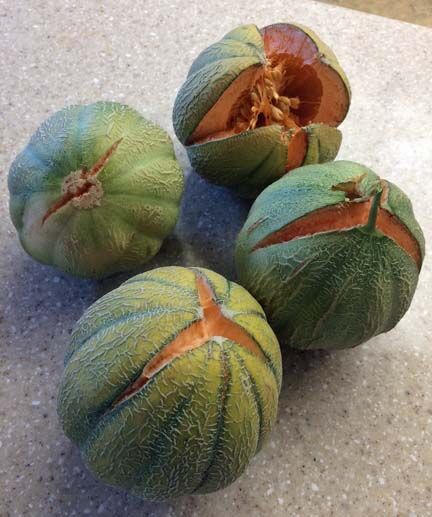Q. A second crop of mini-melons I planted split before it
was ready to harvest. I think it was the heat because the first crop using same
seeds ripened on the vine. These have a mild taste but not very sweet. Is there
a "sow by" date so they will ripen before it gets so hot?
A. Melons split before they are fully mature because the
soil becomes dry and then watering or rain occurs. The result is burst or split
fruit because the fruit swells. This happens with many kinds of fruit, not just
melons. The seed inside the fruit may be mature but the fruit hasn’t yet finished
ripening before it splits.
 |
| Blood orange fruit split |
When a
plant is not getting enough water, but the soil begins to dry, the fruit will
either abort early or the plant will try to finish as much ripening as possible
before the water runs out. This early ripening due to a lack of water can
affect the sugar content or its sweetness, the quality of the fruit, the size
of the fruit or all three!
 |
| Kara Gul pomegranate split and interior rotted |
When the
plant is not getting enough water and begins ripening the fruit, but the soil
gets extremely wet again, water is pumped from the roots into the fruit and it
splits. The fruit might not be fully ripe, but the seeds are oftentimes mature
enough to grow. Applying a thin surface mulch to the soil or growing a variety
that shades the soil better and retains soil moisture may reduce fruit
splitting during the heat. Also, using a plastic mulch when growing vegetables
helps retain water in the soil and reduces splitting.
 |
| Myers lemon fruit split |
The
sweetness or quality of the fruit depends on many things, but weather and
climate are major factors. In fruit and wine culture, this is called the “terroir”
of the crop. Therefore, some varieties of fruit produce better quality fruit
than others in the hot desert versus coastal California. Try a different
variety of mini-melon next time, particularly one that has parents which
performed well in hot climates.
 |
| Nubiana plum fruit split |

This is exactly what I am experiencing by having an automatic timer that waters 7 beds of various varieties in a sand which some people call my garden "soil". Trying to juggle water needs, even with ancient Irrometers, a straw mulch, and commercial drip tape is fraught with peril. Then, of course, a particularly destructive ant thrives under the straw and also burrows deeply under it. They love split melons and tomatoes which they burrow into. Along with 4 types of rodents. And we'll not mention birds and vegetarian lizards of a large size.
ReplyDeleteI've been saying for decades that if I could just turn the Mississippi River on the miserable place for 24 hours every other day I might be able get something ripe to ripen to edibility in the summer.
The best laid schemes o' Mice an' Men
Gang aft agley,
An' lea'e us nought but grief an' pain.
Where are you located?
DeleteThe county area of 29 Palms. 2500 hundred feet. As of this writing due to the results this year and after closely watching the irrometers I'm going to grow only fall/winter items in this area from now on. This is successful. Summer items will be tried near the house where the soil holds a bit more water, is more sheltered, and they escape the brutal afternoon sun, going into shade by 2 PM or a bit sooner.
DeleteThe readings on 6 inch irrometers for the melons and a short height tomato swing from 10 to 50 in a 6 hour period. Watering every 6 hours. Every twelve hours wasn't sufficient. You can see my place and growing attempts on Google maps! I am 400 yards south of Winters and 2 miles west of Lear Ave., main roads in the area. I did have success with a small and earlier melon but some monster called a white Crenshaw had tons of melons but were beaten up by everything mother nature loves out here. Rodent and ant plague this year.